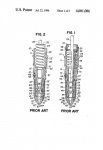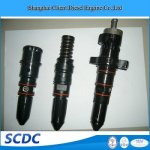There are two ways to set the overhead on an 855. One is the outer base method and the other is the inner base method. The inner base method can ONLY be used on top stop style injectors. The accessory drive pulley is marked differently for the IB method, TDC1-6, A, B, C.
Most of the NHC's that I have seen are marked TDC1-6, VS1-6, 2-5, 3-4. That is used for OB method.
A little schooling first. The base timing for the engine is done by aligning marks on the crank and cam gears. The injection timing is done with shims under the cam boxes by measuring the positive end of injection, (or beginning, I've had instructors tell me both), when the piston is at .203 BTDC. The pumps don't need timing on these, but, the part that drives the pump does. That would be the accessory drive. The accessory drive can be removed and put back into an engine that runs fine w/o timing it to the cam. Nothing physically changes when that happens, it will run the same, however, the next time that someone needs to go into the overhead, they'll be screwed. The pulley that has the marks on it for the overhead set is pressed onto the shaft that needs to be timed to the base engine..the accessory drive shaft.
On an engine that uses top stop injectors, (top stops have a barrel and jamb nut that sets the travel of the injector to match the cam's outer base circle, you can't see the spring on these injectors), an easy way to check to see if the accessory drive is in time is to align the pointer and A on the pulley. The overhead set for top stops goes like this;
I V
A 3 5
B 6 3
C 2 6
A 4 2
B 1 4
C 5 1
Hang an overhead wrench on Injector 5, and bar the engine over while watching the wrench, don't watch the pulley. When the wrench starts to move, ramping up to the OBC on the cam, STOP. Look at the mark. It should be within a 1/2 inch of the pointer...either way...the acc drive is in time, GTG with setting the overhead.
On an engine that uses non top stops, you can check this from the get go, but not as you go through the tune up steps if the engine has been apart. Non top stop injectors have no barrel and jamb nut to set the travel. That's why the overhead set is different. The injector is set on the outer base of the to a specified torque sufficient enough to load the push tube and seat the plunger so the compression in the cylinder won't go back into the injector after positive injection ends. It also plays with injection timing. A loose setting and injection starts later, (slow timing), and a tighter setting starts injection sooner, (fast timing). The same can be done when setting top stops, NO performance gains can be made here. If you wanna mess around with timing for power, smoke, etc. it needs to be done at the cam boxes. The only thing a loose setting does is carbon plungers and tight...too tight... of a setting bends push tubes. Back to acc drive timing. The OBC of the cam is roughly 60% of the lobe, so when the pointer and VS1-6 are aligned, the injector lever for 1 might very well be down, but you have no idea where it is in that 60% of OBC. When any of you attempt to do anything in the overhead, use the above outlined method of checking the timing BEFORE you start disassembling things. If for some reason it isn't in time, PM, e-mail or call me and I can walk you through re marking the pulley.
The overhead set on the NHC for the OBC method goes like this;
A 1 or 6
B 2 or 5
C 3 or 4
Set the valves and injector on the same cylinder, in firing order, setting the injector first to load the rocker shaft,
We'll start with A being cylinder 1 and first in firing order. The injector lever should be down, the nose of the lever pushed down toward the injector. Both valves need to be loose. You can use a click or dial type torque wrench, just make sure it is a known good wrench. The screw shouldn't move much if you are just tuning up, but, if the engine has been apart or you put another injector in it, the screw and injector lever will move quite a bit. You will need to torque the injector screw to 68-72 INCH pounds. That isn't much, but the injector spring tension will be overcome by it and, again, if the engine has been apart, the plunger and nose of the injector lever will be pushed down into the injector, that is what you want, remember you are setting the injector on the outer base circle of the cam..in it's farthest downward position. Lock the jamb nut down...IIRC 40 ft lb and move on o the valves. .014 intake, .027 exhaust. The cross heads are adjustable also, but we'll keave that for another time. Bar the engine over to the next mark, VS2-5, 2-5, sometimes they are marked different, and go through the steps again. 68 to 72 INCH pounds on the injector and .014 and .027 on the valves. Bar it again and repeat. If for any reason it gets hard to bar over...other than trying to overcome the engine compression STOP, something isn't kosher. Loosen things up, regroup and start over. You'll know if the difficulty in barring is from compression if it gets hard and you stop and wait a few seconds and you can continue on and it's easier. You'll also hear a "hissing" noise coming up through the push tube cavities as each piston is brought to TDC on the compression stroke.
I'll see if I can dig up some books with pics, scan them and put them up in the 5T section. I'd make a vid of it but I don't see this stuff at work any more. If anyone by me wants to do a tune up, we could do one here, go through the motions on R&I ing an injector, checking timing and tuning up and put it on digital so it can be posted here as a sticky.
Hope that doesn't confuse anyone. If you need help, you know how to find me.






